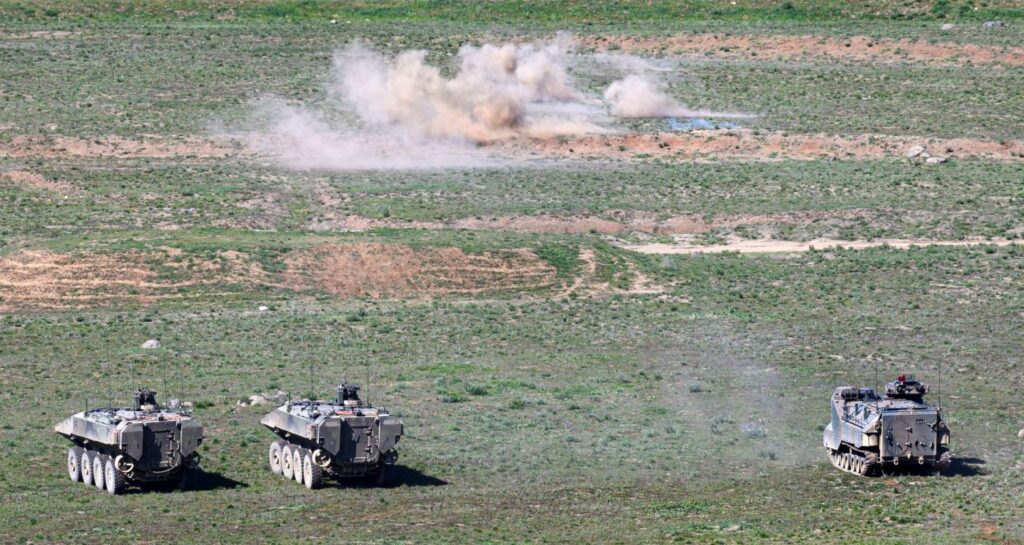
Gunfire roared across training range 409 Delta on Wednesday’s summer-like day at Camp Pendleton as troop carriers raced along roadways firing their high-powered machine weapons systems at a fictional enemy hidden in a distant foothill.
Units from the 1st Marine Expeditionary Force and the Japanese Ground Self-Defense Force have been training together since Jan. 10 in Iron Fist 2022. The annual exercises will last six weeks, ending later this month.
Some 900 Marines and nearly 200 Japanese soldiers have been training off Camp Pendleton’s shoreline, across its beaches, through its ranges and canyons, in the air and out in the harsh desert at Marine Air Ground Combat Center Twentynine Palms.
The Marines and soldiers are working on advanced marksmanship, amphibious reconnaissance and transport, logistics and medical support, and fire support operations.
The training is critical to Japan’s maritime defense strategies, especially as tensions with China and North Korea continue over contest islands and territories.
“We are fortunate to have these exercises in a wonderful area here at Camp Pendleton,” Maj. Gen. Shingo Nashinoki, commanding general of the Amphibious Rapid Deployment Brigade, said Wednesday through a translator. “To conduct long-range fire we can not conduct in Japan has gotten very important for us.”
The Marines were training with their new armored Amphibious Combat Vehicles, which are replacing the Vietnam-era Amphibious Assault Vehicle. The aging AAVs are being phased out and are no longer used in the water or for deployments. The amphibious vehicles are used to transfer troops between ships and shore and can travel on land and in the ocean.
For the Iron Fist training, the Japanese brought over their own AAVs, which were acquired in 2017 and have been overhauled.
As part of the ocean training, Marines and Japanese soldiers practiced getting the heavy, tank-like vehicles through the surf, recovering personnel from the water and transferring crews from one vehicle to another.
“We not only benefit in training with our Japanese allies, but lay fundamental building blocks for our ACV platoon to build upon,” said Lt. Gen. George Smith, commanding general of the 1st Marine Expeditionary Unit at Camp Pendleton. The training is incorporating new protocols and procedures put in place after an AAV sank in 2020 during pre-deployment training off San Clemente Island. Eight Marines and a sailor died.
Among some of the lessons learned from the accident is the importance of “progressive building block training for both the crew and the embarked Marines,” Smith said.
The ACVs training during this exercise will be the first to deploy with a Marine Expeditionary Unit.
The AAV tragedy also resonated with the Japanese military, its officials said. The country has 52 AAVs and safety checks were done on all of the vehicles in August. Before the beach exercises at Red Beach at Camp Pendleton, each vehicle was inspected to ensure its watertight integrity.
Iron Fist has evolved over the decades and is meant to strengthen ties between the U.S. and its ally Japan. While Marines have mentored Japanese soldiers in amphibious combat and live-fire tactics, Marines are also learning techniques from the Japanese soldiers. The goal is to become more familiar with each other’s tactics, technology and strategy, officials said.
Both generals emphasized the values shared by the two militaries and goals of freedom of navigation, a free and open Indo-Pacific and adherence to international laws.
“When these shared values and goals are threatened, we must demonstrate deterrence against those threats,” Smith said. “Exercise Iron Fist is just an example of that deterrence.”
Related Articles
Biden: No Nord Stream 2 pipeline if Russia invades Ukraine
Marines, Leatherneck Foundation and Irvine working to move vintage aircraft to the Great Park
Navy says SEAL candidate dies at California hospital after Hell Week test
VMI to change honor system said to expel Blacks more often
If you see more military aircraft overhead in Southern California, here’s why
